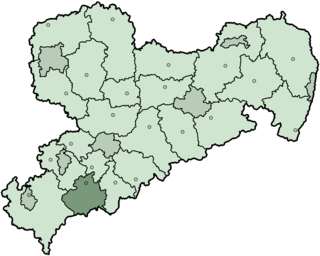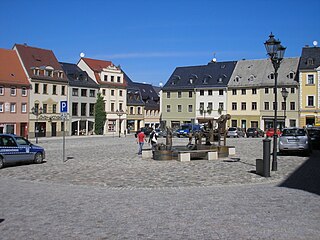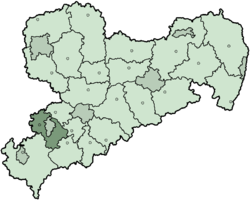History
In early days Zwickau was the starting point for the settlement of a whole region. The first official document of the ”territorim zwickaw” dates from May 1, 1118. The settlement by German farmers took mainly place in the second half of the 12th century. At the same time castles were built. A special area was administered by a bailiff, as a representative of the governor. The Wettiners were the most powerful rulers in Saxony in the 13th century. In the region of Zwickau the sovereign of Schönburg and Wildenfels were given the rule over their comparatively small territories.
With the division of the Saxon country the administrative structures became unclear in Leipzig in 1485. The borderline between albertinian and ernestinian possession was tangent to the Zwickauer city boundary. With the development of the Saxon state uniformed administrative structures began gradually to develop. In the Middle Ages the Saxon area was divided into governor's residence, apart from the central administration. Out of this new jobs developed in the 15th century. The “administrators” (Amtsmann) practised the jurisdiction, and were responsible for the military quantity and public security.
The administrators came from the rural aristocracy. The noble administrator was promoted to the “chief administrator” (Amtshauptmann) during the following century, who usually supervised two to four offices. At the same time the “Kursaxon” territory was divided into districts for a better administration. The district was headed by a “county administrator” (Kreishauptmann or Oberhauptmann).
During the whole Middle Ages and afterwards – even until our century - the city Zwickau with their surrounding area was regarded as a unit, concerning administrative matters.
Ongoing conflicts, for example the Thirty Years' War and the Seven Years' War, influenced the administration negatively.
Zwickau was the seat of the chief administrator. Since 1828, additionally the county administrators ruled from there the Southwest and the middle “Erzgebirge” and the suburbs.
Only in 1835, became the regional administration a new structure. The county administrators were replaced by “district directions” (Kreisdirektion) in Dresden, Leipzig, Bautzen and Zwickau. The chief administrators in Zwickau, Chemnitz, Wolkenstein, Plauen and in the territory of the sovereign of Schönburg belonged to the district direction Zwickau.
The following offices were headed by the chief administrator in Zwickau: Kirchberg, Werdau, Schwarzenberg, Eibenstock and of course Zwickau. Hartenstein, Lichtenstein, Stein, Waldenburg and Glauchau were controlled by the sovereign of Schönburg.
In 1856 an important step toward modern administration was done with the establishment of new administration offices, the “offices of court” (Gerichtsamt). Thereby the old office organization could be overcome.
In 1873 justice and administration were separated. Now the offices of court were only responsible for the law. The “administration crews” (Amtshauptmannschaft) were responsible for the administration. There were four “county administration crews” (Kreishauptmannschaften), which were created as organs of the Saxon government. The county administration crew of Zwickau consisted of the administration crews in Annaberg, Auerbach, Chemnitz, Flöha, Marienberg, Oelsnitz, Plauen, Schwarzenberg and Zwickau.
In 1919 a branch office of Zwickau was opened in Werdau. It became an independent office in 1920, but in 1933 it was affiliated to Zwickau again.
The rural constitution of 1946 as well as the Saxon constitution of 1947 established democratic values in Saxony again, like they had existed before the beginning of the Third Reich.
Now part of the German Democratic Republic (East Germany), the federal state of Saxony was liquidated as part of the administration reforms implemented from July 23, 1952. At the same time the former district Zwickau was divided into the districts Werdau and Zwickau. The area of the district Zwickau received a strong reduction. A considerable part turned into the district Werdau; furthermore, parts of the Zwickauer area were added to the district of Reichenbach. On the other hand the "Mülsengrund" was extracted from the district Glauchau and was affiliated to the district Zwickau.
With the dramatic events in autumn 1989, the Berlin Wall came down. The German Democratic Republic ceased to exist as Germany was re-united. With Saxon parliamentary elections on October 14, 1990, the federal state of Saxony was re-established. On May 6, 1990 local elections took place. At the constituent meeting of district assembly Christian Otto was elected head of the administration of the district Zwickau. In the district Werdau the citizens elected Georg Hamburg to head of the administration.
With the district reform on August 1, 1994, the rural district “Zwickauer Land” was created, seated in Werdau. With the termination of the municipality regional reorganization on January 1, 1999, the district changed its geographical face again. The places Cainsdorf, Mosel, Oberrothenbach and Schlunzig were affiliated to Zwickau against the will of the people living there.
In August 2008, as a part of the district reform in Saxony, the districts of Zwickauer Land, Chemnitzer Land and the urban district Zwickau were merged into the new district Zwickau.

Zwickau (German pronunciation: [ˈtsvɪkaʊ]; is, with around 87,500 inhabitants, the fourth-largest city of Saxony after Leipzig, Dresden and Chemnitz and it is the seat of the Zwickau District. The West Saxon city is situated in the valley of the Zwickau Mulde, and lies in a string of cities sitting in the densely populated foreland of the Elster and Ore Mountains stretching from Plauen in the southwest via Zwickau, Chemnitz and Freiberg to Dresden in the northeast. From 1834 until 1952, Zwickau was the seat of the government of the south-western region of Saxony.

Aue-Schwarzenberg is a former district in Saxony, Germany. It was bounded by the Czech Republic and the districts of Vogtlandkreis, Zwickauer Land, Stollberg and Annaberg.

Chemnitzer Land is a former district in Saxony, Germany. It was bounded by the district of Mittweida, the city of Chemnitz, the districts of Stollberg and Zwickauer Land and the state of Thuringia.

Stollberg is a former district in Saxony, Germany. It was bounded by the district-free city Chemnitz, and the districts Mittlerer Erzgebirgskreis, Annaberg, Aue-Schwarzenberg, Zwickauer Land and Chemnitzer Land.

Plauen is, with around 65,000 inhabitants, the fifth-largest city of Saxony, Germany after Leipzig, Dresden, Chemnitz and Zwickau, the second-largest city of the Vogtland after Gera, as well as the largest city in the Saxon Vogtland. The city lies on the river White Elster, in the Central Vogtlandian Hill Country. Plauen is the southwesternmost city of a string of cities sitting in the densely populated foreland of the Elster and Ore Mountains, stretching from Plauen in the southwest via Zwickau, Chemnitz and Freiberg to Dresden in the northeast. It is the capital of the Vogtland District. Plauen borders Thuringia to the north, and it is also situated near the Saxon border with Bavaria (Franconia) and the Czech Republic (Bohemia).

Waldenburg is a town in the district Zwickau in Saxony, Germany. The castle was owned by the House of Schönburg from 1378 until 1945. The pottery town of Waldenburg lies in the valley of the Zwickauer Mulde. The environment is characterized by forest areas, river meadows and the hilly landscape of the Erzgebirge foothills.

Glauchau is a town in the German federal state of Saxony, on the right bank of the Mulde, 7 miles north of Zwickau and 17 miles west of Chemnitz by rail. It is part of the Zwickau district.

The Chemnitz–Adorf railway is a branch line in Saxony, Germany that was built and operated by the Chemnitz-Aue-Adorfer Eisenbahn-Gesellschaft (CAAE). The 115 km long line originally ran from Chemnitz in a southwesterly direction along the valley of the River Zwönitz to Aue. From Aue the line ran along the Zwickauer Mulde to Muldenberg and up to Schöneck and through Markneukirchen to Adorf in Vogtland.
Erzgebirgskreis is a district (Kreis) in the Free State of Saxony, Germany. It is named after the Erzgebirge, a mountain range in the southern part of the district which forms part of the Germany–Czech Republic border. It borders the districts of Vogtlandkreis and Zwickau, the urban district Chemnitz, the district Mittelsachsen and the Czech Republic.
Mittelsachsen is a district (Kreis) in the Free State of Saxony, Germany.
Zwickau is a district (Kreis) in the Free State of Saxony, Germany.

The Saxon Uplands, Saxon Hills or Ore Mountain Foreland is a strip of countryside of about 200 m to 500 m above sea level (NN) high, in the German state of Saxony, that lies immediately north of the German Ore Mountains and runs mainly through the areas of Zwickauer Land, Zwickau, Chemnitzer Land, Chemnitz, Mittelsachsen and the country south of Dresden. It borders on the Upper Pleißeland to the extreme west, the Ore Mountain Basin in the south and the Mulde Loess Hills to the north and east.

The Bezirk Karl-Marx-Stadt, also known as Bezirk Chemnitz, was a district (Bezirk) of East Germany. The administrative seat and the main town was Karl-Marx-Stadt, renamed back to Chemnitz during the reunification of Germany.

The Chemnitz–Riesa railway is a two-track and electrified mainline railway in the German state of Saxony, originally built and operated by the Chemnitz-Riesa Railway Company. The line was opened between 1847 and 1852 and is one of the oldest railways in Germany. The line runs from Riesa via Döbeln to Chemnitz and is part of the Berlin–Chemnitz route.
The Dresden–Werdau railway is an electrified, double-track main line in the German state of Saxony. It runs from Dresden via Freiberg, Chemnitz and Zwickau to Werdau wye, where it joins the Leipzig-Hof railway.
The Zwickau–Schwarzenberg railway is a main line railway in the German state of Saxony. It extends from Zwickau through the valleys of the Zwickauer Mulde and the Schwarzwasser via Bad Schlema and Aue to Schwarzenberg. It opened in 1858 and it is one of the oldest railways in Germany. It is now served by Regionalbahn trains, operated by Erzgebirgsbahn between Zwickau and Johanngeorgenstadt.
Glauchau station is the main station of Glauchau in southwest of the German state of Saxony on the Dresden–Werdau line. Glauchau also has another station at Glauchau-Schönbörnchen.

Stein Castle is a Saxon castle located southeast of Zwickau in the village of Stein in the municipality of Hartenstein on the rocky banks of the Zwickauer Mulde in the east German state of Saxony.

The Central Saxon Hills, is a region of Hügelland with indistinct boundaries in the centre of the German state of Saxony.

Jan Löffler is a German politician (CDU). Since 2009 he is a member of the Saxon Landtag. Currently he is the vice chairman and treasurer of the CDU-faction in the Saxon Landtag.
















